

|
A garden is only as good as the ground that it's planted in. Discussion forum for the many ways to improve the soil where we plant our gardens.
|
 |
|
|
Thread Tools | Display Modes |
|
|
#1 |
|
Tomatovillian™
Join Date: Jun 2011
Location: Idaho
Posts: 241
|
Permiculture, and in particular Hugelkultur has intrigued me for a while (see [a href="http://www.richsoil.com/hugelkultur/"]this link[/a] for a general intro to hugelkultur).
This past winter a big limb cracked and fell off the boxelder tree in my empty lot garden, and it inspired me to have a try at a small hugelkultur-ish bed. Technically, this is an "in ground" Hugel bed (one of the many variants), and I kind of messed with the system to meet my own needs, so hopefully the whole thing works. P-) Here's the downed limb - 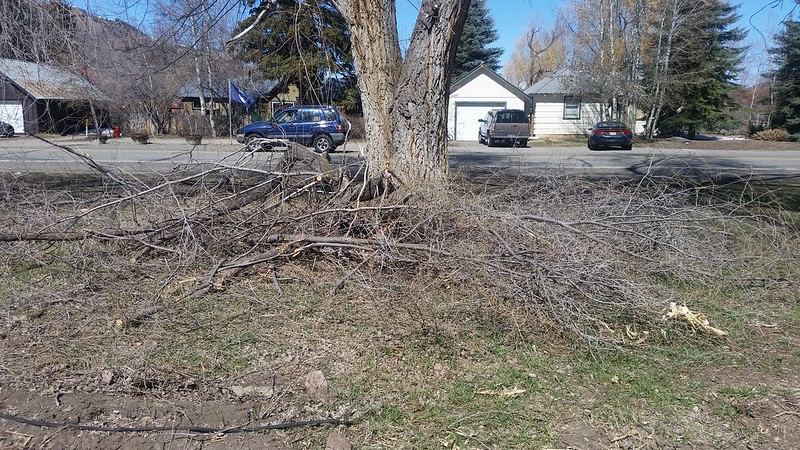 So... Step 1. Dig a hole. This one is 4' by 8' and 4' deep.  I think it's cool how different the soil layers are in the dirt piles. On the right is the dark topsoil (top foot or so). On the left in front is the next layer down, a lighter sandy clay (old river edge?), behind that (and below it in the hole) is a denser, darker clay. Step 2. Add large logs. I formed a rough pyramid. 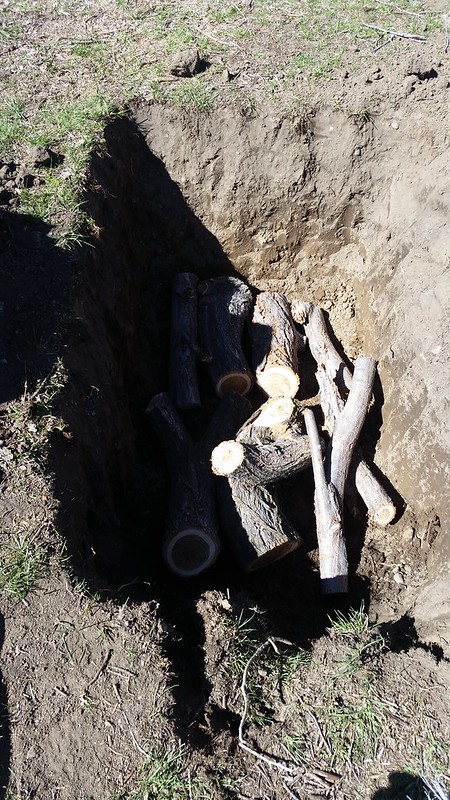  I stuffed some of the inter log spaces with sod from the hole, and added some un-composted garden waste (from the top of the compost pile) into other spaces. Step 3. Add some old corn stalks from last season. The idea is to keep lots of air in the mix, so everything can break down over time, and have lots of looseness in the soil for the plant roots to snake through.  Step 4. Pile on some hot, active compost from the pile. I want lots of nice composting organisms going to work down there. I took a garden fork and kind of "shook" the whole thing so it really got down in there.  Step 5. Add a first layer of soil back to the hole. I used the "mid" sandy clay-ish stuff. Then, I added a layer of much finer diameter branch "tips". Layers of wood/rotting garden waste help keep the C/N ratio in the pile on track. above that, I stacked on some partially rotted (upper/mid compost stack) tomato vines from last year. 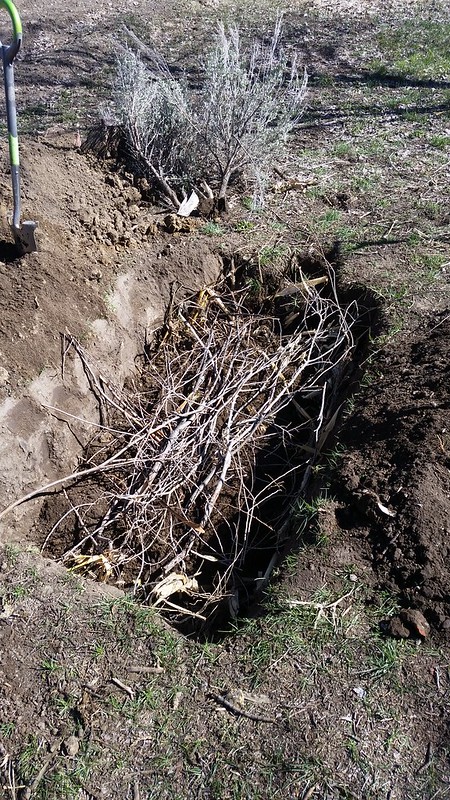 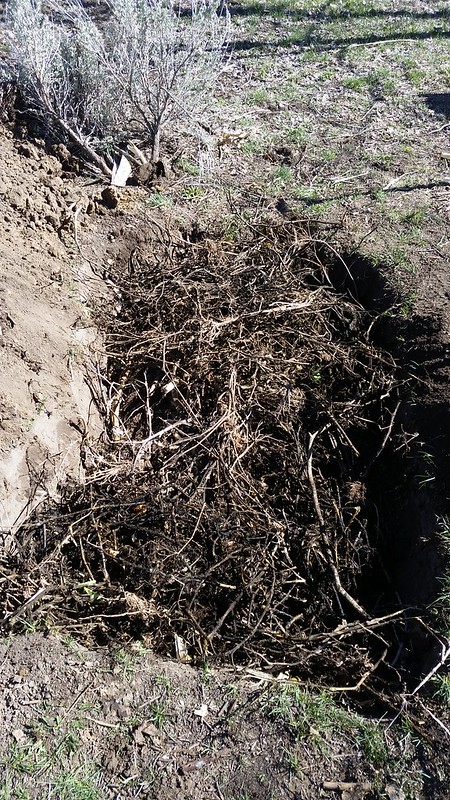 Step 6. Add a layer of soil to the above, "shake" it with the fork, and then repeat the corn stalks/smaller branch tips.  More dirt, more partly rotted tomatoes.  At that point I hooked up the hose sprayer and watered the heck out of the thing. Just as you would a compost pile. Step 7. One more thin layer of soil, and we're back to level with the ground. This is where I diverge from traditional Hugelkultur. Basically, I want to grow in this bed, starting this year, and I think having a live, active, compost pile all the way to the top would rob too much nitrogen from the system, so I'm essentially building a very rich row on top of said pile, but squash roots (the plants of choice the first couple years) will have no problem reaching down to the bottom of this thing. Because of that I added a fair amount of blood meal to the following layers to counter some of the nitrogen loss. 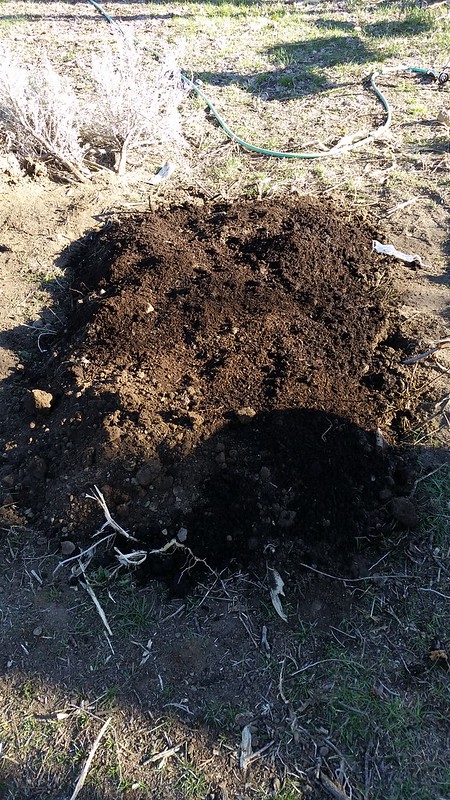 Step 8. Alternate layers of soil, composted steer manure, and finished compost (3"ish per layer) 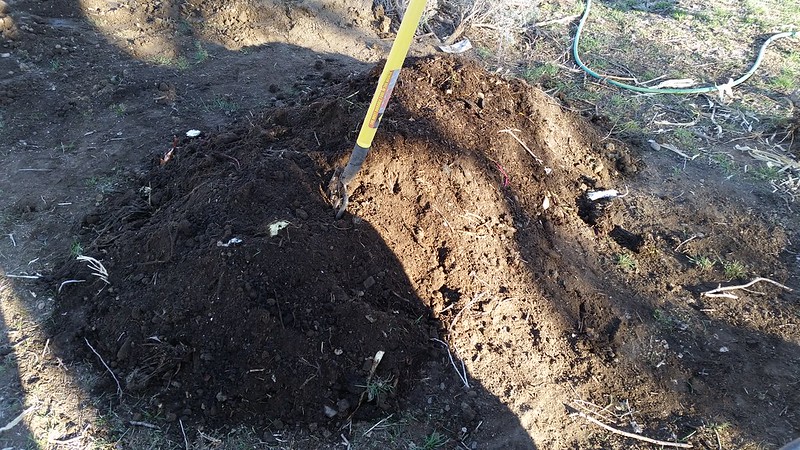 Then fork it all a bit to mix things up and keep air spaces down into the lower layers Step 9. Final layers of of finished compost (both steer manure and from the house), layered with the top soil I dug out of the hole. Finally I put some more active, hot, compost on top (should be just about finished in two months or so when I actually plant this bed).  Step 10. Almost done. Final step is to add drip tape for irrigation, followed by wood chips (the branches in the background will be chipped tomorrow). Then IRT 100 mulch to finish it off. I won't add the plastic mulch until just before I plant, for air exchange, and because I expect the pile to shrink and lower a bit over the next two months. 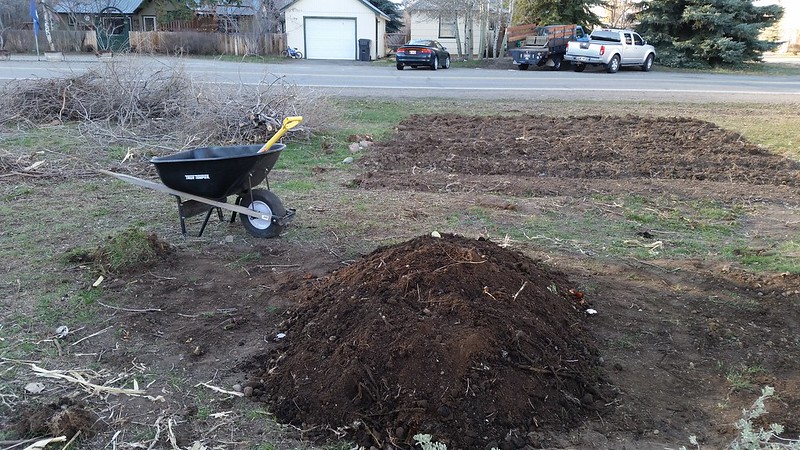 This is going to be home to two squash plants (Macre Giant and an elite-genes Atlantic Giant). One on each end of the bed. In the middle will be 4 stalks of corn (living trellis for beans). And some beans around the corn as nitrogen fixers. Kind of a three sisters planting on steroids. The theory around these beds is that they only get better with time as all the wood breaks down, so I'm excited to see how it all goes. Last edited by PaddyMc; April 4, 2016 at 05:23 PM. |
|
|

|
|
|
#2 |
|
Tomatovillian™
Join Date: Jul 2010
Location: Jupiter, FL (10b)
Posts: 97
|
This is really cool - love the pictures. Thank you for making the effort to share. Am interested in seeing how this turns out.
|
|
|

|
|
|
#3 |
|
Tomatovillian™
Join Date: Feb 2006
Location: Den of Drunken Fools
Posts: 38,539
|
One of my raised beds is like that.
The layers as you called them are called horizons this is the dividing line between the soil layers. It has always intrigued me because they are so distinct and abrupt. To me it shows something changed very fast in geologic time. I used to work with a guy for a long time and one day I found out he used to be with the US geologic survey and had a degree in geology. So I asked him about the strange round river rocks that are on top of the soil where I live and in other places deep sand. This is hilly country not flat ground. The rocks you would see in a river bed not up on hills. He told me it was more than likely caused from massive flooding from glacial outflow. Nothing you can find on line because everything is too simplified. As for the raised bed I dug a big hole because I needed soil so I filled it back in with wood sticks and leaves and built a raised bed on top of it. Worked out great but be prepared to add more soil as the stuff rots. A thousand years from now someone will be baffled as to what it is so add some old bones and trinkets to make them think it was a burial site.  Worth |
|
|

|
|
|
#4 | |
|
Tomatovillian™
Join Date: Jun 2011
Location: Idaho
Posts: 241
|
Quote:
 |
|
|
|

|
|
|
#5 |
|
Tomatovillian™
Join Date: Feb 2006
Location: Den of Drunken Fools
Posts: 38,539
|
|
|
|

|
|
|
#6 |
|
Tomatovillian™
Join Date: Mar 2015
Location: USA NJ zone 6B
Posts: 228
|
Great looking hugelbed, now you need to make more
 . One of my obsessions. Can't / won't plant any tree or bush without digging in some rotten wood at the bottom of the hole first. I wish I knew about it before I planted all the trees in my yard. . One of my obsessions. Can't / won't plant any tree or bush without digging in some rotten wood at the bottom of the hole first. I wish I knew about it before I planted all the trees in my yard.
__________________
(:>= |
|
|

|
|
|
#7 |
|
Tomatovillian™
Join Date: Aug 2014
Location: albuquerque
Posts: 308
|
I put in a small hugelkultur bed last year. Planted Swiss Chard in it, production seemed OK. I think the wood was 6 inches beneath the surface. There was a row of mushrooms along the drip tapes and it smelled like sauteed mushrooms every time it was irrigated. Looking forward to this years growth.
|
|
|

|
|
|
#8 |
|
Tomatovillian™
Join Date: Jun 2015
Location: Pulaski County, Arkansas
Posts: 1,239
|
interesting. if that is your native soil, I got dirt envy, nice. no wonder them taters grow so well in Idaho.
|
|
|

|
|
|
#9 |
|
Tomatovillian™
Join Date: Feb 2006
Location: Den of Drunken Fools
Posts: 38,539
|
|
|
|

|
|
|
#10 |
|
Tomatovillian™
Join Date: Mar 2014
Location: Greenville, South Carolina
Posts: 3,099
|
I just wish I could dig in my dirt...I mean your soil already looks amazing.
|
|
|

|
|
|
#11 |
|
Tomatovillian™
Join Date: Jun 2011
Location: Idaho
Posts: 241
|
We do have rather great native soil. As Worth said, it's largely glacial till and old river bed (we're about four blocks away from the river). It does tend to be quite rocky in places, though I like to think of that as "well drained"
 Central Idaho's mountains are kind of perfect for gardening, except for the cold, which does limit things somewhat. |
|
|

|
|
|
#12 |
|
Tomatovillian™
Join Date: May 2016
Location: Williamsburg VA Zone 7b
Posts: 1,110
|
I put in four 4X8 hugelkultur beds last fall. We have heavy clay and I wanted raised bed so I dug down 2 - 3 feet, added new and rotten wood, and then covered it with the excavated dirt. I mixed in compost to the upper layers of soil.
We had a very wet spring in Virginia followed by one of the driest, hottest Augusts on record. The hugelkulture beds are outperforming all others! I've pulled about half of the peppers and tomatoes from the other raised beds that were diseased or not producing - almost none from the h/k beds. I've added another 20 feet for next year. |
|
|

|
|
|
#13 |
|
Tomatovillian™
Join Date: Apr 2008
Location: California Central Valley
Posts: 2,543
|
We built a couple hugelkultur beds in the small front yard over a year ago...
|
|
|

|
|
|
#14 |
|
Tomatovillian™
Join Date: Aug 2015
Location: Zone 6a Denver North Metro
Posts: 1,910
|
If there's such a thing as the Jimmy Hoffa Tomato, we may be looking at a clue.
|
|
|

|
|
|
#15 |
|
Tomatovillian™
Join Date: Mar 2013
Location: Colorado
Posts: 361
|
I had a similar idea when I was digging out one of the ponds by the garden. As the saying goes...the look on my wife's face was "priceless".
__________________
“Live as if you'll die tomorrow, but farm as if you'll live forever.” Old Proverb |
|
|

|
 |
|
|
